|
Training
Aids
|
Martingales are
probably the most common training devices used
today. Properly adjusted, they can compensate for a
green rider’s hands, help teach the mule to give to
the bit and keep the mule’s head safely under
control. There are two basic types of martingale –
those that have a fixed position and those that
adjust with the rider’s hands. Each has benefits and
drawbacks depending on the situation.
Choosing the right martingale
for the job, and knowing how to properly adjust it,
makes the difference between a training aid or a
useless piece of equipment, or even worse a
dangerous situation. |
Standing Martingales
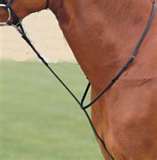 The
most basic type is the standing martingale, or the tie-down
as it known to the Western rider. The standing martingale is
a fixed length that goes from the cinch, up between the
forelegs and attaches to a noseband. Some versions have a
strap around the mule’s neck, or run through a ring on the
breast collar but the main feature is that it is a static
length and can not be adjusted by the rider’s hands.
Standing martingales are particularly useful in situations
where the rider might not have fine control of his hands,
such as jumping, roping or speed events. The standing
martingale or tie-down should be adjusted so that the mule’s
head can be held in a comfortable normal position at all
gaits, and the downward pressure on the noseband comes into
play if the mule tosses his head or tries to raise it above
the bit. An overly short tie-down can cause problems by
forcing the mule into an unnatural position while working,
which can create soreness and stress injuries. Also, there
are times when it is vital that the mule be able to raise
his head – if a mule stumbles, for example, he will toss his
head and neck up to help regain his balance. If the tie-down
interferes with this, the mule could fall. A too-loose
standing martingale does nothing to help the mule and
becomes just another piece of equipment that can
Useful with mules who carry their heads too
high and with the mule who throws its head backwards
endangering the rider. A correctly fitting martingale
allows the mule complete freedom of head and neck when
performing. Should never be fitted to a drop noseband which
would interfere with action of the bit. Used with a
snaffle. The
most basic type is the standing martingale, or the tie-down
as it known to the Western rider. The standing martingale is
a fixed length that goes from the cinch, up between the
forelegs and attaches to a noseband. Some versions have a
strap around the mule’s neck, or run through a ring on the
breast collar but the main feature is that it is a static
length and can not be adjusted by the rider’s hands.
Standing martingales are particularly useful in situations
where the rider might not have fine control of his hands,
such as jumping, roping or speed events. The standing
martingale or tie-down should be adjusted so that the mule’s
head can be held in a comfortable normal position at all
gaits, and the downward pressure on the noseband comes into
play if the mule tosses his head or tries to raise it above
the bit. An overly short tie-down can cause problems by
forcing the mule into an unnatural position while working,
which can create soreness and stress injuries. Also, there
are times when it is vital that the mule be able to raise
his head – if a mule stumbles, for example, he will toss his
head and neck up to help regain his balance. If the tie-down
interferes with this, the mule could fall. A too-loose
standing martingale does nothing to help the mule and
becomes just another piece of equipment that can
Useful with mules who carry their heads too
high and with the mule who throws its head backwards
endangering the rider. A correctly fitting martingale
allows the mule complete freedom of head and neck when
performing. Should never be fitted to a drop noseband which
would interfere with action of the bit. Used with a
snaffle.
Running Martingales
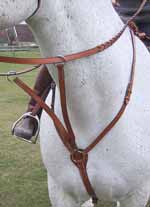 Running
martingales consist of two rings through which the reins are
threaded. The rings are held on a strap that attaches to the
cinch or breast collar. Sometimes there is a neck strap. If
not the martingale is called a “training fork.” Adjust the
strap so that when the mule’s head is in an acceptable
position, there is no downward pressure, but if the mule
raises his head and neck, the rider can apply some rein
pressure and the rings will direct the pressure downward.
The rider, by tightening or releasing the reins while
riding, can control how much and how long the pressure from
the martingale is applied. Running martingales are usually
used with direct pressure bits such as ring snaffles.
Be very careful about using either
running or German martingales with curb bits. Also,
always use rein stops with a running martingale. If the
snaps on the reins become hooked on the sliding rings, a
mule could panic and fall or rear. I routinely use running
martingales on colts, so that if a problem happens I will
have a tool ready at hand to help me regain control. I
adjust my martingale so that it only comes into play if the
mule’s head is extremely high.
Designed to create a steadier feel of the bit in the mule's
mouth even with head movement and attempts at evading the
feel of the bit. Helpful on green animals who have yet to
learn to seek the bit and feel comfortable with a steady
contact. Encourages a steady head carriage and gives the
rider a bit more control during disobedient sessions.
Used with a snaffle. Running
martingales consist of two rings through which the reins are
threaded. The rings are held on a strap that attaches to the
cinch or breast collar. Sometimes there is a neck strap. If
not the martingale is called a “training fork.” Adjust the
strap so that when the mule’s head is in an acceptable
position, there is no downward pressure, but if the mule
raises his head and neck, the rider can apply some rein
pressure and the rings will direct the pressure downward.
The rider, by tightening or releasing the reins while
riding, can control how much and how long the pressure from
the martingale is applied. Running martingales are usually
used with direct pressure bits such as ring snaffles.
Be very careful about using either
running or German martingales with curb bits. Also,
always use rein stops with a running martingale. If the
snaps on the reins become hooked on the sliding rings, a
mule could panic and fall or rear. I routinely use running
martingales on colts, so that if a problem happens I will
have a tool ready at hand to help me regain control. I
adjust my martingale so that it only comes into play if the
mule’s head is extremely high.
Designed to create a steadier feel of the bit in the mule's
mouth even with head movement and attempts at evading the
feel of the bit. Helpful on green animals who have yet to
learn to seek the bit and feel comfortable with a steady
contact. Encourages a steady head carriage and gives the
rider a bit more control during disobedient sessions.
Used with a snaffle.
The German Martingale
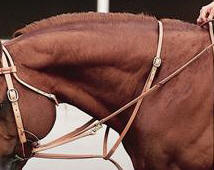 German
martingales are the most complicated of the martingales, but
also the most
sophisticated. Instead of simply sliding the reins through
rings, the German reins actually split (usually achieved by
hooking the martingale part of the reins to rings sewn onto
the direct
reins). This second pair of reins continues through the ring
of the snaffle, and on down to the cinch. The advantage is
that when the mule is responding correctly to bit pressure,
there is no martingale effect, but if he raises his neck the
martingale reins immediately come into play.
When properly adjusted, there is
little chance of over-flexing too, as the only pressure will
be direct from the rider’s hands to the bit. German
martingales can be a bit intimidating to a novice, as there
are extra straps and adjustments to get used to, but overall
they are very effective for teaching the mule to give to the
bit. Another advantage to German martingales is that they do
not limit lateral (sideways) movement of the reins.
Used with a snaffle. German
martingales are the most complicated of the martingales, but
also the most
sophisticated. Instead of simply sliding the reins through
rings, the German reins actually split (usually achieved by
hooking the martingale part of the reins to rings sewn onto
the direct
reins). This second pair of reins continues through the ring
of the snaffle, and on down to the cinch. The advantage is
that when the mule is responding correctly to bit pressure,
there is no martingale effect, but if he raises his neck the
martingale reins immediately come into play.
When properly adjusted, there is
little chance of over-flexing too, as the only pressure will
be direct from the rider’s hands to the bit. German
martingales can be a bit intimidating to a novice, as there
are extra straps and adjustments to get used to, but overall
they are very effective for teaching the mule to give to the
bit. Another advantage to German martingales is that they do
not limit lateral (sideways) movement of the reins.
Used with a snaffle.
The Pulley Martingale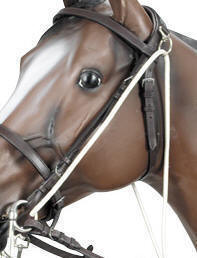
This is a variation of the running martingale. With a
pulley system it allows greater lateral movement of head and
neck. Very useful in polo or gymkhana events.
Used with a snaffle
The Combined Martingale
A
combination of running and standing, this martingale. Gives
the effect of both of those. Used with
a snaffle.
The Irish Martingale
 A
short piece of leather the length of the of the distance
between the reins under a mule's
neck. Rings on either end allow the reins to be passed
through like the running martingale. Prevents the reins
from being thrown around. Used with a
snaffle. A
short piece of leather the length of the of the distance
between the reins under a mule's
neck. Rings on either end allow the reins to be passed
through like the running martingale. Prevents the reins
from being thrown around. Used with a
snaffle.
Running Reins
Fitted either with the reins running through the rider's
hands, bit rings, and back to the girth (least severe
position) or through the rider's
hands, bit rings and down between the mule's
front legs to the breast color (more severe setting), has
the effect of teaching the mule to lower its head and round
its frame. While this is very effective, lasting training
only occurs when the rider teaches the mule to lower its
head, tuck its nose, round its back and work off the
hindquarters. This is not a control device in that a mule
could easily run off or buck, both of which is helped by the
lower head set. Used with a snaffle.
Draw Reins
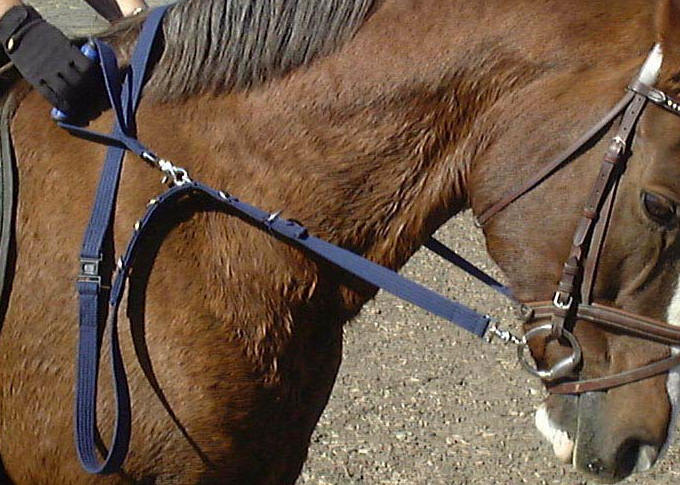 The
draw rein is actually on continuous rein that passes from
the poll, down the sides of the face, through the bit rings
from the outside to inside and straight to the rider's
hands. This aid encourages the mule to raise his head by
mimicking the action of a gag bit. Draw reins are useful
with mules who get their heads too low, those inclined to
buck, those who lean on the bit or those who like to slide
the reins out of the rider's
hands by lowering their heads. Used
with a snaffle. The
draw rein is actually on continuous rein that passes from
the poll, down the sides of the face, through the bit rings
from the outside to inside and straight to the rider's
hands. This aid encourages the mule to raise his head by
mimicking the action of a gag bit. Draw reins are useful
with mules who get their heads too low, those inclined to
buck, those who lean on the bit or those who like to slide
the reins out of the rider's
hands by lowering their heads. Used
with a snaffle.
The Chamboon
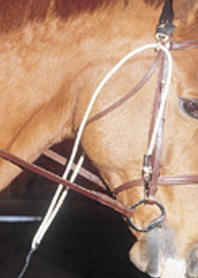 This
training aid encourages the mule to lower the head and neck
thru poll pressure as well as the bit. Used during riding.
This training device comes in handy during lunging and free
work. It encourages the mule to lower and head and neck,
round his back and stay in frame. The mule works corrects
himself when he raises his head too high.
Used with a snaffle. This
training aid encourages the mule to lower the head and neck
thru poll pressure as well as the bit. Used during riding.
This training device comes in handy during lunging and free
work. It encourages the mule to lower and head and neck,
round his back and stay in frame. The mule works corrects
himself when he raises his head too high.
Used with a snaffle.
The de Gogue
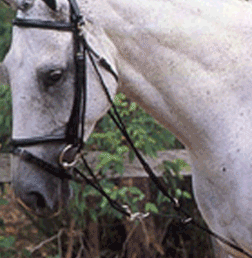 This
is an extension of the Chamboon but used while riding.
This
training aid encourages the mule to lower the head and neck
thru poll pressure as well as the bit. Used during riding.
Used with a snaffle. This
is an extension of the Chamboon but used while riding.
This
training aid encourages the mule to lower the head and neck
thru poll pressure as well as the bit. Used during riding.
Used with a snaffle.
Richard Shrake's
Rhythm Collector
This is another device used while lunging. It is a single
rein that passes over the poll down both sides of the face
through the bit, through the front legs, around the rib cage
and tied at the withers. During exercise, the mule learns
to round, lower his head and learn the rhythm of his own
shoulders. Very effective. Used with
a snaffle.
Spurs
 Spurs
are
not
instruments of torture, To the contrary, they are
designed to simply reinforce or to Spurs
are
not
instruments of torture, To the contrary, they are
designed to simply reinforce or to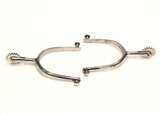 apply leg aids more
precisely. They can be used to get a mule's
attention and to punish gently, but firmly. English type
spurs are generally of the blunt type, while
Western
spurs generally have rowels with varying degrees of
sharpness. apply leg aids more
precisely. They can be used to get a mule's
attention and to punish gently, but firmly. English type
spurs are generally of the blunt type, while
Western
spurs generally have rowels with varying degrees of
sharpness.
Crops and Whips

Used
in conjunction with other aids, crops, bats and whips are
used to finish the message sent by the other aids. They can
be used to provide additional pressure to an aid or to get
the animals attention. They are significant in establishing
communication while riding side saddle. They should
never be used to beat
the mule. Most mules who have had the crops and whips
applied correctly have no fear whatsoever of the them.
Nosebands
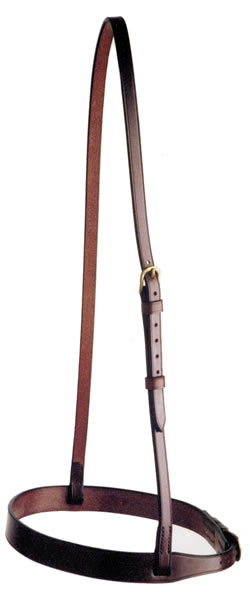 Nosebands
are designed to keep the mule's
mouth closed so that contact with the bit can be
maintained. They come in a variety of types. They should
not interfere with the mule's
breathing nor should they be used with heavy hands.
Nosebands are generally part English bridles but not
western. Be sure and check rulebooks to see if they are
considered legal equipment in the English classes you
enter. They are illegal in all western classes except speed
and cattle. Nosebands
are designed to keep the mule's
mouth closed so that contact with the bit can be
maintained. They come in a variety of types. They should
not interfere with the mule's
breathing nor should they be used with heavy hands.
Nosebands are generally part English bridles but not
western. Be sure and check rulebooks to see if they are
considered legal equipment in the English classes you
enter. They are illegal in all western classes except speed
and cattle.
|